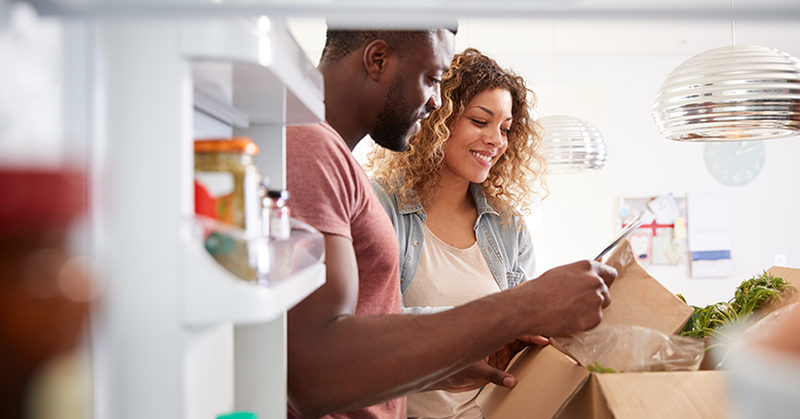Kraft, Peapod Explore eGrocery Growth Opportunities for 2022
Grocery has gone digital during the pandemic, but the impetus wasn’t solely the surge in eCommerce usage. More precisely, the drivers of change are consumers who have adopted hybrid shopping behaviors and now demand more continuity and convenience as they move between online and offline spaces. Quotient’s Senior Commerical Leader of eCommerce, Mike Merna, had the chance to discuss this new eGrocery landscape with Shobha Kansal, eCommerce Lead at Kraft Heinz, and Margit Kittridge, Director of Advertising Technology at Peapod Digital Labs (an Ahold-Delhaize USA company).
Keep reading for our top takeaways from the session, and for even more insight, watch the on-demand session recording below.
The State of eCommerce in 2022
If 2020 set the stage for eCommerce usage to surge, then 2021 was all about brands and retailers building a solid foundation to meet consumers’ changing needs. For Peapod, this meant creating a modern, next-generation, cloud-ready infrastructure for their eCommerce site; strengthening onsite retail media programs; and developing more ways to enable quicker grocery deliveries and pickups.
On the advertiser side, Kraft focused on being in the right place at the right time for shoppers who demonstrated an ongoing need for convenience and online solutions. It accomplished this by working hand-in-hand with partners like Peapod to plan retail media programs with a shopper-first mindset.
"One of Kraft Heinz’ main goals of 2022 will be to continue to make eCommerce a part of the company and our total industry’s DNA. We really need to live omnichannel in everything we do, and we believe we can do this by staying ahead of rapidly changing consumer needs and continuing to partner with retail media partners to measure the outcomes of our joint media programs and tweak future programs to better serve the needs of shoppers."
Looking ahead to 2022, the goal for both Kraft and Peapod is to support seamless omnichannel grocery experiences. This means that whether someone prefers to shop at physical store locations, schedule curbside pickups, have their groceries delivered or a mix of these methods, they should be able to find convenient solutions supported by reliable, fast and seamless technology.
"With the rapid growth of retail media, I think that 2022 will challenge the retail media networks to come together and work on standardization of key metrics, formats and measurement solutions. Since retail media is becoming its own media channel, it will require new processes to implement on both the advertiser and retailer level so it becomes easier to buy, optimize and measure."


How Brands and Retailers Can Support Omnichannel
With omnichannel as the focus, what steps can advertisers and retailers take to ensure they’re supporting customers with the right type of content to fit each shopper’s needs?
For Kraft, the answer is focusing on the fundamentals of omnichannel shopping. Whether that’s delivering strong content on retailers’ websites and apps, analyzing data and measurement metrics to tweak future programs, developing a strong search strategy or focusing on pricing fundamentals across the in-store and online landscape, Kraft recognizes that it has to stay agile in order to remain relevant in today’s changing landscape. For example, when addressing ongoing supply change and out of-stock challenges, Kraft was able to incorporate new data and technology solutions to protect customer experiences and revenue growth.
On the retail side, Peapod is focusing on hyper-personalization and measurement. By customizing its omnichannel offerings to suit shoppers’ individual needs, Peapod is able to drive incremental sales using personalized loyalty campaigns and offers, enhance the value and relevance of retail media solutions, and deliver more dynamic and personalized messages to all customers via leading technology solutions. Measurement also comes into play here because it allows Peapod to connect multiple retail media touchpoints via a consistent measurement solution.


How Data Informs Planning
Finally, the session closed with a discussion about data. As third-part cookies depreciate, first-party data has become a key focus in the grocery-retail landscape. Peapod relies heavily on first-party data when deciding how to hyper-personalize the consumer shopping experience. Its short-term goal is to leverage first-party data to enhance the onsite experience—whether that be through a personalized offer or sponsored product ad—to measure and optimize the value of those touchpoints. First-party data also comes into play when measuring return on ad spend (ROAS), which is a key metric for Peapod’s advertiser partners when evaluating the impact of retail media assets.
"With the help of Quotient, our strategic partner to measure the effectiveness of ADUSA’s retail media assets, we offer flexible reporting with various attribution windows and both click- and impression-based attribution metrics."
On the advertiser side, Kraft uses data to make investment decisions across its portfolio. Access to reliable data empowers Kraft to make informed media decisions and decide which KPIs it should target in collaboration with retail media partners.
We hope you enjoyed this recap of our session “Growing and Thriving in the New eGrocery Landscape.” For more information on how you can create campaigns that meet consumers’ changing needs, contact us at hello@quotient.com.




